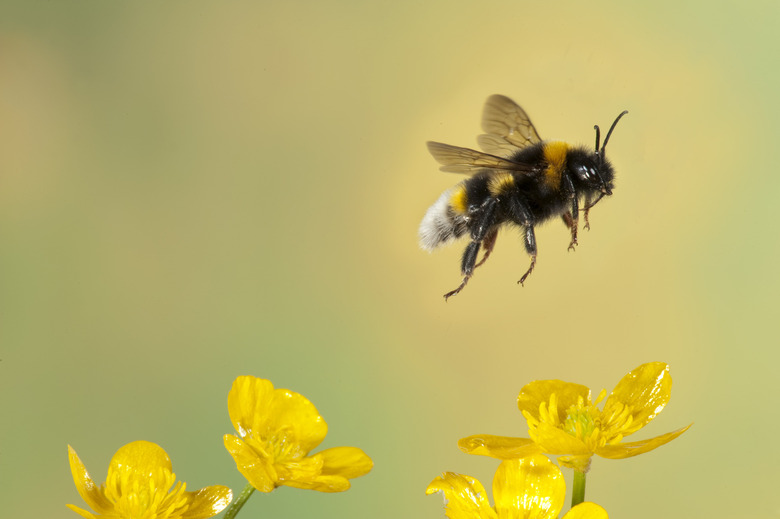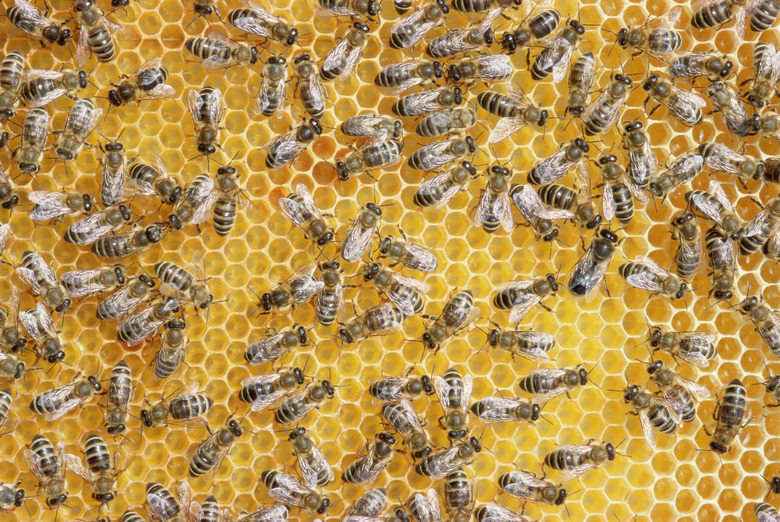I've Found A Hive Of Bees At My House: Now What?
If you look at it one way, a beehive in your house should be a cause for celebration considering the importance of bees to the ecosystem. However, looked at realistically, a bee nest inside your walls is a major problem, and it isn't one you can ignore. You could be liable if someone gets stung, or you could get stung yourself, and if the colony is well-established, the weight of the honeycomb could be putting stress on your home's framing. That's assuming, of course, that it's a colony of honeybees and not some other type of bees, but in all likelihood, it's honeybees.
If you had been expecting a honeybee invasion, you could have taken measures to prevent it, but like most homeowners, you probably weren't expecting one. Right from the start, it's best to accept the fact that there's little you can safely do about the colony yourself, and you're going to need professional help. Whether you call an exterminator to eradicate the hive or a beehive removal expert to safely relocate it is up to you, but if you can appreciate all that bees do for life on planet Earth, you'll probably opt for removal. You may even get a jar or two of honey in the bargain.
Tip
A beehive isn't something you can or should ignore, but removing it isn't a job most homeowners can do, and trying to do it yourself can be dangerous. Call a beekeeper or bee removal expert to have the hive professionally removed.
Identify the Bees
Most homeowners become aware of a bee colony in their home by noticing one or two of the insects at a time landing on the side of the house and disappearing through a crack in the siding or between the siding and a window. Honeybees will also form colonies in trees and outbuildings — anywhere there's a structure to support the hive — but they don't burrow in the ground. If you see bees emerging from a hole in the ground, they could be polyester bees, sweat bees, mining bees, or another bee species, but they aren't honeybees. Ground-dwelling species are generally solitary, although they do sometimes form small groups, and they pose no threat. The same is true for carpenter bees that you may find emerging from a hole in the wall (which it probably bored by itself).
The one ground-dwelling species that is cause for concern isn't a bee at all; with its long body bearing yellow and black stripes, it only looks like one. Yellow jackets are wasps, and they are the critters that swarm around your picnic looking for food, especially meat. Yellow jackets are seasonal, and their nests are most active in the late summer. These insects both swarm and sting, and they're especially aggressive when you get too close to the nest, so once you've found one, stay away from it. The nest will be gone when winter comes, and because yellow jackets don't return to old nests, it won't be a problem next year.
Worldwide, there are about 20,000 different bee species. About 4,000 of them live in North America, and plenty of them are interested in your garden, including bumblebees — those miniature flying pom-poms — leafcutter bees, long-horn bees, and carder bees. None of them are as social as honeybees, and none form hives. If you can get a good look at the bee that landed on your windowsill and you don't notice a rounded, hairy abdomen and the familiar honey-colored stripes, you don't have to worry about a beehive and can go about your business while the bee does the same.
Honeybees Are Beneficial, and They're Endangered
Some other bees are pollinators, particularly bumblebees, but none rival honeybees, which are responsible for pollinating 70 of the 100 or so crops that feed 90 percent of the world. They also pollinate flowers and other plants, and without them, humans would be in big trouble, so it's no comfort to know that they are endangered. Business Insider notes that 2018 saw a 40 percent die-off of bee colonies in the U.S. and points to this as a possible mass-extinction event. This is a problem with devastating consequences for the ecosystem, and it needs to be addressed as urgently as climate change.
There are actions every homeowner can take to remedy the situation. One is to plant more bee-friendly plants in the garden because as the saying goes, if you build it (a bee-friendly garden), they will come. The other actions are immediately relevant to anyone with a beehive in the walls of the home: Avoid using pesticides and provide a safe haven. In other words, instead of trying to get rid of your bee problem by killing the bees — which you can definitely do — consider hiring a beekeeper to relocate them to a new home in an apiary.
How Not to Handle a Beehive
A homeowner of the DIY persuasion may want to avoid the expense of professional bee removal or extermination by addressing the situation directly. That usually isn't a good idea unless you have experience with bees and the proper equipment, but if this is your preferred approach, there are some things you definitely shouldn't do:
- Don't ignore the beehive: Unlike yellow jackets, bees remain active throughout the winter, and they don't abandon their hives. That means the longer you wait to address the situation, the bigger the hive will grow, the heavier the honeycomb will become, and the more difficult removal will be when you do get around to it. If you leave the bees alone, they'll leave you alone, but if someone ventures too close to the hive — perhaps a painter or gardener — the bees could swarm to protect their nest, and honeybee swarms are dangerous, especially if the bees are Africanized. Multiple bee stings can cause a severe allergic reaction and can kill.
- Don't spray the bees with anything or try to smoke them out: You're inviting a swarm if you disrupt a beehive by spraying it with water or trying to smoke them out, and you aren't doing your house any favors either. It's also a bad idea to spray pesticides but for a different reason. If you manage to get close enough to spray inside the walls, you might kill the bees, but then you have a mass of dead bees rotting inside the wall. Moreover, spraying pesticide into the wall contaminates the honey, which then becomes poisonous and must be discarded as hazardous waste. This is one reason spraying a beehive with over-the-counter insecticides is illegal in California and other places.
- Don't try to barricade them: You might be thinking that the best course of action is to seal the opening to the hive with caulk so the bees can't get out, but you're inviting disaster in two ways. First, the bees might indeed die, and you're stuck with decomposing insect bodies inside the wall. The bees fall into a pile, and decomposition produces bad odors and liquids that can permeate the structure and lead to costly repairs. On top of that, you still have to get rid of all the honey, which can weigh as much as 100 pounds if the colony is well-established. The second possibility is that they find a new entry point, and it may be inside the house, which is additional cause for concern.
Beehive Removal Is the Safest Option
Bee removal isn't a DIY project. An experienced beekeeper or bee removal expert will first identify where the hive is located by tapping on the wall and listening for the hum, sometimes using a stethoscope, and then drilling small pilot holes and inserting wires to locate the edges. Once the location has been pinpointed, someone has to make a hole in the wall that is large enough to remove it. This is best done by a contractor working in conjunction with the bee removal expert who can patch the hole when the hive is gone. After the hole has been cut, there are two options.
The first option is to build and install a one-way screen or funnel that allows the bees to leave but doesn't allow them to get back in, and if that strategy is successful, the bees will gradually buzz off and establish a new colony elsewhere. That can take a while, though, so the second, faster option is for an experienced beekeeper to physically remove the bees and transfer them to boxes for relocation, sometimes using a bee-safe vacuum. It goes without saying that no one — especially not children or pets — should be in the immediate area when this operation is ongoing.
After the bees are gone, the honeycomb can be removed, and this is where you get your two jars (at least) of honey. After that, the cavity must be thoroughly cleaned and disinfected before the hole in the wall is repaired. Beeswax has a distinct odor that bees recognize, so it's important to remove all of it to prevent a new swarm from being attracted there. If bees are swarming but haven't yet established a colony, they are easier to remove. An experienced beekeeper can often do it by brushing the swarm into a box.
Where to Find a Local Beekeeper
Virtually every community has at least one beekeeper, and many have several, and while removing a beehive is a lot of work, they are often only too happy to add to their apiaries, although they probably won't work for free. If you can't find an independent local beekeeper or bee removal expert by searching online, try the nearest Beekeepers' Association or your county office, which may keep a record of local beekeepers. You can also call a pest control company. Bee control may not be one of the company's specialties, but it may be able to refer you to someone else.
How to Prevent a Future Beehive
The experience of removing a beehive can be arduous, so you probably don't want another one to get established, and if you haven't already had the experience, it's best to avoid it. The first thing to do is seal all the cracks in the siding, soffits, window and door casings, and foundation that might provide the bees accessibility to the wall cavities. You can do this by spreading caulk, screwing or gluing metal or wooden plates over holes, or using epoxy putty. Bees can climb through small openings, so any hole or crack more than 1/4 inch wide should be sealed.
Bees are sensitive to smell, and there are many smells they don't like, including garlic, cinnamon, vinegar, and peppermint. Spray solutions of water and essential oil or vinegar and distribute garlic or cinnamon powder liberally outside the house near any openings you aren't able to seal. Burning citronella candles will also keep bees away, although it isn't a very practical long-term solution. A better idea is to plant peppermint near places where bees are likely to be attracted. They won't be attracted anymore and will hopefully look for a hollow tree in which to nest.
References
- Business Insider: Last Year, 40% of Honey-Bee Colonies in the US Died. But Bees Aren't the Only Insects Disappearing in Unprecedented Numbers
- Pests.org: How To Get Rid of Bees
- University of California Statewide Integrated Pest Management Program: Removing Honey Bee Swarms and Established Hives
- Environment America: Save the Bees
- Green Matters: How to Humanely Remove a Beehive From Your Home
- Savvy Gardening: Types of Bees Common in Gardens


